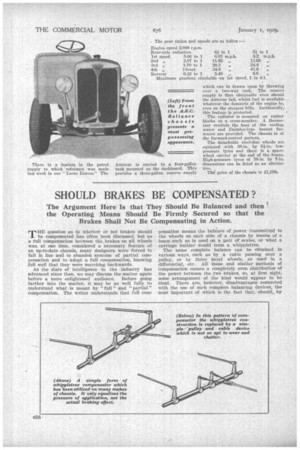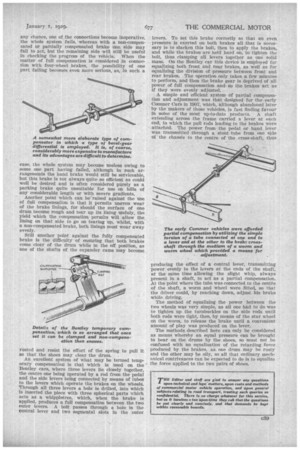SHOULD BRAKES BE COMPENSATED?
Page 38

Page 39

If you've noticed an error in this article please click here to report it so we can fix it.
The Argument Here Is that They Should Be Balanced and then the Operating Means Should Be Firmly Secured so that the Brakes Shall Not Be Compensating in Action.
T"question as to whether or not brakes should be compensated has often been discussed, but as a full compensation between the brakes on all wheels was, at one time, considered a necessary feature of an up-to-date chassis, many designers were forced to fall in line and to abandon systems of partial compensation and to adopt a full compensation, knowing full well that they were marching backwards.
As the state of intelligence in the industry has advanced since then, we may discuss the matter again before a more enlightened audience. Before going farther into the matter, it may be as well fully to understand what is meant by "full" and "partial" compensation. The writer understands that full corn
pensation means the balance of power transmitted to the wheels on each side of a chassis by means of a beam such as is used on a pair of scales, or what a carriage builder would term a whippletree.
The same complete balance can be obtained in carious ways, such as by a cable passing over a pulley, or by three bevel wheels, as used in a differential, etc. All these and similar methods of -compensation ensure a completely even distribution of the power between the two brakes, so, at first sight, some arrangement of the kind would appear to be ideal. There are, however, disadvantages connected with the use of such complete balancing devices, the most important of which is the fact that, should, by
any chance, one of the connections become inoperative, the whole system fails, whereas with a non-compensated or partially compensated brake one, side may fail to act, but the remaining side will still be useful in checking the progress of the vehicle. When the matter of full compensation is considered in connection with four-wheel brakes, the possibility of one part failing becomes even more serious, as, in such a case, the whole system may become useless owing to some one part having failed, although in such arrangements the hand brake would still be serviceable, but this brake is not always quite so efficient as could well be desired and is often considered purely as a parking brake quite unsuitable for use on hills of any considerable length or with severe gradients.
Another point which can be-raised against the use of full compensation is that it permits uneven wear of the brake linings, for should the surface of one drum become rough and tear up its lining unduly, the yield which the compensation permits will allow the lining on that side to go on tearing up, whilst, with a non-compensated brake, both linings must wear away evenly.
Still another point against the fully compensated brake is the difficulty of ensuring that both brakes come clear of the drum while in the off position, as one of the shafts of the expander cams may become rusted and resist the effort of the spring to pull It so that the shoes may clear the drum.
An excellent system of what may be termed temporary compensation is that which is used on the Bentley cars, where three levers lie closely together, the centre one being operated by a rod from the pedal and the side levers being connected by means of tubes to the levers which operate the brakes on the wheels. Through all three levers a hole is drilled, into which Is inserted the piece with three spherical parts which acts as a whippletree, which, when the brake is applied, produces a full compensation between the two outer levers. A bolt passes through a hole in the Central lever and two segmental slots in the outer levers. To set this brake correctly so that an even pressure is exerted on both brakes all that is necessary is to slacken this bolt, then to apply the brakes, and while the brakes are held hard on, to tighten the bolt, thus clamping all levers together as one solid mass. On the Bentley car this device is employed for equalizing both front and rear brakes, as well as for equalizing the division of pressure between front and rear brakes. The operation only takes a few minutes to perform, and then the brake gear is .deprived of all power of full compensation andso the brakes act as if they were evenly adjusted.
A simple and efficient system of partial compensation and adjustment was that designed for -the-early Commer Cars in 1907, which, although abandoned later by the makers of those vehicles, is fast finding favour In some of the most up-to-date products. A shaft extending across the frame carried a lever at each end, to which the pull rods leading to the brakes were attached. The power from the pedal or hand lever was transmitted through a stout tube from one side of the chassis to the centre of the cross-shaft, thus
producing the effect of a central lever, transmitting power evenly to the levers at the ends of the shaft, at the same time allowing the slight whip, always present in a shaft, to act as a partial compensation. At the point where the tube was connected to the centre of the shaft, a worm and wheel were fitted, so that the driver could, by reaching down, adjust his brake while driving.
The method of equalizing the power between the two wheels was very simple, as all one had to do was to tighten up the turnbuckles on the side rods until both rods were tight, then, by means of the star wheel on the worm, to release the brake until a convenient amount of play was produced on the lever.
The methods described here can only be considered as means whereby an equal pressure can be brought to bear on the drums by the shoes, so must not be confused with an equalization of the retarding force produced by the brakes, as one drum may be rusty and the other may be oily, so all that ordinary mechanical contrivances can be expected to do is to equalize the force applied to the two pairs of shoes.
















































